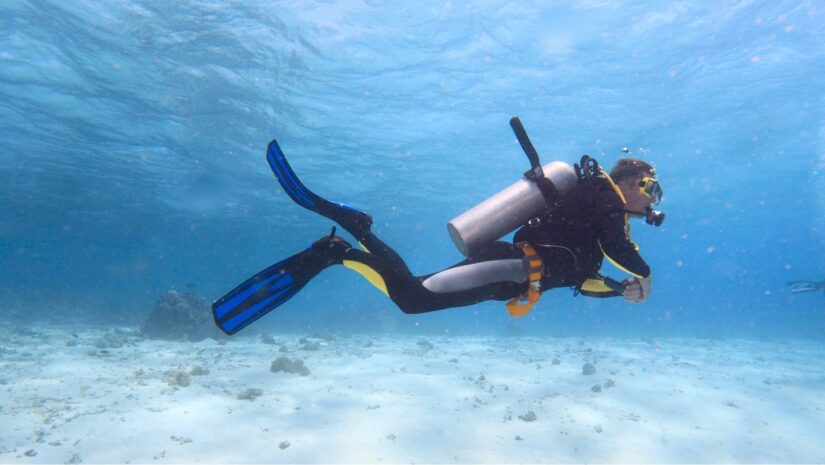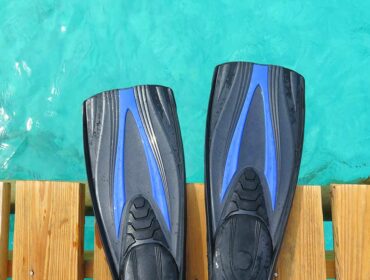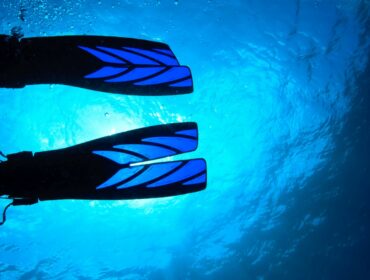When we first start scuba diving, we don’t think about how the finning techniques we use underwater to propel ourselves. As long as we’re moving wherever we want, we kick without remembering the tips our open water instructors gave us. But with time and experience, polishing even our most basic scuba skills becomes our number one aspiration. This desire eventually motivates us to be more air-efficient (scuba gold!) and be better divers overall.
What are the Basic Scuba Finning Techniques You Should Use?

Finning or kicking underwater not only affects how you move underwater, as employing the proper diving kick also helps you enjoy more efficient dives. This results in less air consumption and reduced physical fatigue. Just as importantly, you won’t be disrupting aquatic environments as much when you employ the correct finning technique.
Let’s look at the most common finning techniques that divers use underwater:
- Flutter kick
- Frog kick
- Modified flutter kick
- Scissor kick
- Short frog kick
- Helicopter turn
- Reverse or back kick
- Dolphin kick
The Flutter Kick
The flutter kick is perhaps the one of the top finning techniques you’ll learn from your instructor during your scuba diving lessons. Performing this kick involves moving your legs up and down in opposing directions. Of course, flutter kicks require you to keep your legs relatively straight, though you can bend them a little, too.
When you perform the kick properly, it’ll give you propulsion and a great forward thrust on the downward stroke of each fin. But keep in mind that your hips and legs should align with your torso while you’re doing flutter kicks. Also, your knees should bend slightly on the upward stroke and straighten on the downward stroke while your fins stay pointed.
The Frog Kick
Frog kicks are one of the most popular scuba kicks among cave divers as these techniques help them avoid kicking up silt or sand in confined spaces. The frog kick keeps your body and upper legs in a straight, horizontal trim.
But unlike the flutter kick (where your knees are slightly bent), frog kicks allow you to fully bend your knees so that your fin blades point upward on a steep diagonal. You’ll also need to kick like how you would do a breaststroke kick, but you’ll have to twist your ankle or lower leg at a right angle. This unique movement will help your fins achieve the correct position.
Frog Kick vs. Flutter Kick: What are their Pros & Cons?

Many divers find it relaxing to use the frog kick as a general cruising kick, either by itself or alternating it with the flutter kick every few minutes. You can also do frog kicks when you’re near delicate coral, silty or sandy seabeds, and sea creatures. They can also be done inside large caves. But these techniques won’t work very well with split fins and several other types of fins.
Long, gentle strokes are the best partners for flutter kicks. These strokes use the muscles at the front of your thighs to do most of the work and are also perfect for thrusting yourself forward. But always remember: diving isn’t all about speed. Flutter kicks are more tiring: they might cause divers to use up all their energy if they use this technique. That’s why experienced divers don’t use flutter kicks a lot underwater.
Another disadvantage that comes with using the flutter kick is that it kicks up silt or sand so it can easily disturb nearby seabeds or marine life. That’s why it’s best not to use this diving kick when you’re near the seabed or along a wall.
The Modified Flutter Kick
Modified flutter kicks are the most common scuba diving kicks among many divers. You’ll need relatively straight thighs, sharply bent knees, and kicks from the lower part of your legs and ankles to do the technique. Modified flutter kicks will let divers move underwater with less efficiency and effort, and they might even help keep your fins away from coral and silt. These kicks are perfect for slow, relaxed dives and divers with floaty feet.
The Scissor Kick
The scissor kick (or split kick) is the flutter kick and the frog kick combined. It involves upward and downward strokes, with the resulting stroke creating power as it ends. But the scissor kick has a fairly different leg motion: divers widen their legs and sharply bring them together, then keep their legs in that position for a glide count. You use one leg for the upward stroke and the other for the downward kick.
Most divers love using the scissor kick since it’s powerful with no necessary effort. Plus, the technique is excellent for cruising, propelling you forward (as an initial kick), and resting your leg muscles. Scissor kicks will also let you swim near the substrate without using your fins to make contact with inhabitants or stirring up sand or silt.
The Short Frog Kick
In the frog kick’s modified version, divers don’t move their legs as far out as the standard frog kick. Instead, it restricts your thigh and knee movement while you slightly move your hips and kick your ankles. Short frog kicks (or bent-knee cave diver kicks) are good, gentle kicks with less thrust, making it the best technique to use in confined spaces and near sandy seabeds or aquatic species.
The Helicopter Turn
Helicopter turns are highly efficient for changing direction underwater. By using these finning techniques, you can turn and look behind you while you’re in your current position. Helicopter turns are frog kicks and reverse kicks combined into a single technique, with each kick using one leg. To do this technique, you must move your fins apart slowly and horizontally in an opposing back and forth motion while rotating them and your ankles.
You can use helicopter turns during wreck or cave diving, or when you’re swimming above delicate seabeds.
Reverse or Back Kick
A top skill that scuba divers can master, the reverse or back kick lets you move away from objects or swim backward (hence its name). It’s not an easy or elegant kick, but it’s useful in many situations.
This technique is almost a complete reverse of the frog kick: Your fins work through the first half when your legs move out and away from you. They pull your legs close to your body, scoop forward, and stop halfway so that you can’t move forward. Once your fins complete the actions above, they’ll delicately put your legs back to the starting point and repeat the technique.
Reverse or back kicks will work best with underwater photographers, diving instructors, and divers focusing on a specific subject. They’re also perfect for reversing out of holes or keeping you stable in your current position underwater.
Dolphin Kick
Dolphin kicks are one of two kicking techniques that freedivers often use while they’re underwater. Lots of freedivers deem these kicks as the better choice for going up and down the water column. The dolphin kick lets you move your legs together in an up and down motion, and you can use paired fins or monofins to do the technique.
Dolphin kicks are powerful kicks that increase your thrust underwater, make your dive more streamlined, and engage more muscle groups, helping to spread out the workload. But divers only do them in short bursts since they consume plenty of energy.





